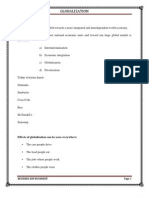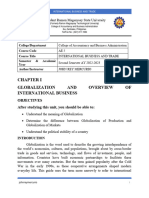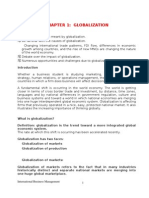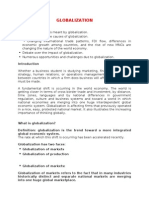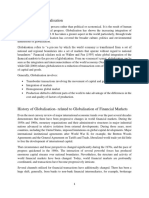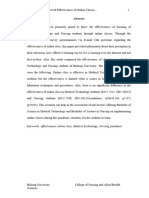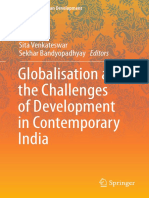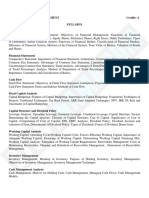0 ratings0% found this document useful (0 votes)
Daryl Kayle Santos
Daryl Kayle Santos
Uploaded by
darylkaylesantos21The document provides an overview of international business and globalization. It defines international business as commercial activities that cross international borders, such as importing, exporting, and foreign direct investment. It also discusses how globalization and technology have increased market interconnectivity and allowed firms to internationalize their operations. Both the opportunities and challenges of globalization for businesses are addressed, including accessing new markets and facing intense foreign competition.
Copyright:
© All Rights Reserved
Available Formats
Download as DOCX, PDF, TXT or read online from Scribd
Download as docx, pdf, or txt
Daryl Kayle Santos
Daryl Kayle Santos
Uploaded by
darylkaylesantos210 ratings0% found this document useful (0 votes)
The document provides an overview of international business and globalization. It defines international business as commercial activities that cross international borders, such as importing, exporting, and foreign direct investment. It also discusses how globalization and technology have increased market interconnectivity and allowed firms to internationalize their operations. Both the opportunities and challenges of globalization for businesses are addressed, including accessing new markets and facing intense foreign competition.
Copyright
© © All Rights Reserved
Available Formats
DOCX, PDF, TXT or read online from Scribd
Share this document
Did you find this document useful?
Is this content inappropriate?
The document provides an overview of international business and globalization. It defines international business as commercial activities that cross international borders, such as importing, exporting, and foreign direct investment. It also discusses how globalization and technology have increased market interconnectivity and allowed firms to internationalize their operations. Both the opportunities and challenges of globalization for businesses are addressed, including accessing new markets and facing intense foreign competition.
Copyright:
© All Rights Reserved
Available Formats
Download as DOCX, PDF, TXT or read online from Scribd
Download as docx, pdf, or txt
0 ratings0% found this document useful (0 votes)
Daryl Kayle Santos
Daryl Kayle Santos
Uploaded by
darylkaylesantos21The document provides an overview of international business and globalization. It defines international business as commercial activities that cross international borders, such as importing, exporting, and foreign direct investment. It also discusses how globalization and technology have increased market interconnectivity and allowed firms to internationalize their operations. Both the opportunities and challenges of globalization for businesses are addressed, including accessing new markets and facing intense foreign competition.
Copyright:
© All Rights Reserved
Available Formats
Download as DOCX, PDF, TXT or read online from Scribd
Download as docx, pdf, or txt
You are on page 1/ 3
Chapter 1.
Introduction to International Business
Sir taught me a lot. According to Sir Alex, International Business refers to commercial ventures
that cross international boundaries, like exporting, importing, foreign direct investment, and
international franchising. It offers chances for businesses to broaden their customer base, gain
access to new resources, and diversify their business models. Navigating various legal systems,
cultural nuances, and political hazards, for example, are difficulties that come with doing
business internationally. Companies must also consider how their operations may affect the
environment and nearby populations. Careful preparation, solid alliances, and a dedication to
moral and ethical business practices are necessary for a successful global company. International
business is becoming a more crucial component of many firms' growth and success plans as a
result of the world economy's rising globalization.
The economic pursuits of businesses that engage in trade and investment beyond international
boundaries are referred to as international business. This can be done in foreign countries and
encompasses a variety of tasks such as product procurement, production, and marketing. Cross-
border trade can involve the exchange of goods, services, money, capital, technology, know-
how, and labor.
Businesses engage in international trade for a variety of reasons, such as opening up new
markets, acquiring assets and skills, and lowering expenses. The expansion of international trade
has been facilitated by factors such as the globalization of markets and production, regional
economic integration, and the expansion of international financial and investment flows.
Hazards associated with doing business internationally include commercial, cross-cultural,
national, and currency hazards. When a cultural misunderstanding undervalues some human
worth, there is a cross-cultural risk.
An overview of the nature and reach of international business is provided in this reading. The
practice of trading and investment activities by businesses across international borders is
described as international business. The authors emphasize that all value-adding tasks, such as
sourcing, production, and marketing, can be carried out abroad. Additionally, they emphasize
how businesses expand internationally by exporting, foreign direct investment, licensing,
franchising, and joint ventures.
The authors go on to explain that as a result of the ongoing economic integration and growing
interdependence of nations on a global scale, as well as the emergence of regional economic
integration blocs, the growth of international investment and financial flows, the convergence of
consumer lifestyles and preferences, and the globalization of production, there is a globalization
of markets that is causing a greater integration and interdependency of national economies.
Chapter 2. Globalization of Markets and the Internationalization of the Firm
Globalization and technological advancements are two significant factors that have changed the
international business landscape as the world becomes more connected. Market globalization
describes the rising interdependence of governments, buyers, producers, and suppliers across
borders as well as the interconnection of national economies. Businesses can now see the globe
as a single, vast market for goods, services, capital, labor, and expertise thanks to globalization.
The results of market globalization are numerous and wide-ranging, with both positive and
negative effects.
Businesses are obliged to internationalize as a result of market globalization. Internationalization
is more successfully implemented by proactive businesses than by reactive ones. For instance,
Vodafone has production and marketing facilities all over the world and serves 200 million
customers across 30 nations. Technological advancements give businesses the ability to expand
internationally. Technology advancements lower the cost of conducting business internationally,
allow even tiny businesses to do so, aid in global activity coordination, and lessen the geographic
distance.
The impact of information technology is particularly notable. subsequently the late 1980s, the
cost of computer processing decreased by 30% annually and has subsequently continued to do
so. The impact of IT on our daily lives, including computers, cellphones, tablets, the Internet,
Google, social media, and more, has led to increases in productivity across the organization. The
increasing number of Internet users and the drop in the cost of international communication have
both made a big difference. Millions of individuals are connected globally through the Internet
and systems that rely on it, including intranets, extranets, and email, which also makes the global
market accessible to all businesses, big and small.
Technology for communications is also essential. It encompasses the Internet, wireless
technology (3G to 5G), satellites, optical fiber, and telephony. With the aid of computer-aided
design (CAD), robotics, and production lines controlled and monitored by microprocessor-based
controls, manufacturing is now both low-scale and low-cost, which has significantly reduced the
cost of transportation. Technology advancements in the 1960s resulted in the creation of fuel-
efficient jumbo planes, massive ocean-going freighters, and containerized shipping, which
sparked a fast expansion in global trade.
Long-term, globalization typically results in improved living conditions, more effective resource
management, and wider access to goods, services, and technology. Market liberalization appears
to raise income levels.
For businesses that are expanding internationally, market globalization opens up a plethora of
new commercial prospects. However, it also brings along fresh dangers and fierce competition
from overseas rivals. Businesses that can successfully handle the challenges of
internationalization and market globalization will be more competitive in the world market.
International Trade Explained World 101
The "International Trade Explained | World101" video offers a basic introduction to international
trade and its effects on the world economy. The film starts by describing international trade as
the transfer of commodities and services between nations before going on to discuss its
advantages and disadvantages.
The enhanced productivity and efficiency that come with a specialization is one of the key
advantages of global trade that is addressed in the movie. Countries can create more of the goods
and services they are greatest at producing at a cheaper cost when they specialize in doing so,
which can benefit consumers in both countries. Additionally, since countries that engage in trade
have access to new markets and technologies, trade can support economic growth and
development.
The film does, however, concede that there might be drawbacks to trade, particularly for those
who work in industries that may be replaced by cheaper imports or outsourcing. The video
makes the point that governments should assist impacted employees and communities because
this can result in job losses and pay stagnation.
I felt that overall, the film gave a clear and succinct review of global commerce and its effects on
the economy. The video's graphics and animations were interesting and aided in illuminating the
main ideas being covered. However, I would have preferred to hear more discussion of how
global trade affects the balance of power among nations and the geopolitical linkages that exist
between them. Additionally, although the negative effects of global trade were briefly discussed
in the movie, I believe it would have been beneficial to go into more detail about some of the
specific industries and employees that have suffered because of trade liberalization.
The "International Trade Explained | World101" film, in my opinion, serves as a helpful
introduction to the subject of international trade. Although it could have been more thorough, it
was a useful starting point for anyone wishing to comprehend the fundamentals of how
international trade operates and how it affects the world economy.
You might also like
- Final Project Report (Thesis) 2137+2156+2157 PDF50% (2)Final Project Report (Thesis) 2137+2156+2157 PDF70 pages
- Test Bank For Principles of Macroeconomics 5th Edition N Gregory Mankiw100% (40)Test Bank For Principles of Macroeconomics 5th Edition N Gregory Mankiw3 pages
- Mita Paryani: International Business ProjectNo ratings yetMita Paryani: International Business Project12 pages
- Chapter 1 Introduction To International BusinessNo ratings yetChapter 1 Introduction To International Business19 pages
- Complete Download of Solution Manual for International Business, 15/E 15th Edition : 0133457230 Full Chapters in PDF DOCX100% (3)Complete Download of Solution Manual for International Business, 15/E 15th Edition : 0133457230 Full Chapters in PDF DOCX47 pages
- Business Environment Presentation: Master of Commerce, Honours (Mcom-Hons)No ratings yetBusiness Environment Presentation: Master of Commerce, Honours (Mcom-Hons)95 pages
- Globalization & Drivers of GlobalizationNo ratings yetGlobalization & Drivers of Globalization7 pages
- MB0037 International Business ManagementNo ratings yetMB0037 International Business Management23 pages
- What Is Globalization?: and Some of The Investment Flows Among Advanced Economies, Mostly Focusing On The United StatesNo ratings yetWhat Is Globalization?: and Some of The Investment Flows Among Advanced Economies, Mostly Focusing On The United States5 pages
- International Business Management or Business EnviormentNo ratings yetInternational Business Management or Business Enviorment141 pages
- International Business Business Transactions Crossing National Borders at Any Stage of The TransactionNo ratings yetInternational Business Business Transactions Crossing National Borders at Any Stage of The Transaction10 pages
- An International Business Project: Scenario?No ratings yetAn International Business Project: Scenario?9 pages
- Globalization Creates A Global Marketplace With More Competition, As Local Companies Have To Compete With Foreign Companies For CustomersNo ratings yetGlobalization Creates A Global Marketplace With More Competition, As Local Companies Have To Compete With Foreign Companies For Customers4 pages
- Ngee Ann Polytechnic School of Engineering Diploma in Logistics Management Global Logistics Management Pre-Requisites Introduction To LogisticsNo ratings yetNgee Ann Polytechnic School of Engineering Diploma in Logistics Management Global Logistics Management Pre-Requisites Introduction To Logistics5 pages
- Globalization: Effects of Globalization Can Be Seen EverywhereNo ratings yetGlobalization: Effects of Globalization Can Be Seen Everywhere23 pages
- International Business Management As Per VTUNo ratings yetInternational Business Management As Per VTU141 pages
- INTRODUCTION TO INTERNATIONAL BUSINESS TRADE InbtNo ratings yetINTRODUCTION TO INTERNATIONAL BUSINESS TRADE Inbt2 pages
- Honor Is A Smartphone Brand Majority Owned by A State-Owned Enterprise Controlled by The Municipal Government of Shenzhen. It Was Formerly Owned by Huawei, Which Sold The Brand in November 2020 ToNo ratings yetHonor Is A Smartphone Brand Majority Owned by A State-Owned Enterprise Controlled by The Municipal Government of Shenzhen. It Was Formerly Owned by Huawei, Which Sold The Brand in November 2020 To15 pages
- Social Dilemmas - The Psychology of Human Cooperation - Paul Van Lange, Daniel P. Balliet, Craig D.No ratings yetSocial Dilemmas - The Psychology of Human Cooperation - Paul Van Lange, Daniel P. Balliet, Craig D.209 pages
- Interview With Holcim - Finacial ExpressNo ratings yetInterview With Holcim - Finacial Express3 pages
- Price and Output Determination Under Perfect CompetitionNo ratings yetPrice and Output Determination Under Perfect Competition12 pages
- CCIR Academy - Application and Interview Guidelines - v3No ratings yetCCIR Academy - Application and Interview Guidelines - v333 pages
- Political Science 669: International Political Economy: Course DescriptionNo ratings yetPolitical Science 669: International Political Economy: Course Description27 pages
- Business Economics Notes Lecture Notes Lectures 1 10No ratings yetBusiness Economics Notes Lecture Notes Lectures 1 1055 pages
- B. Financial Management Theory Questions Review - 5 Marks Questions (CPC5A)No ratings yetB. Financial Management Theory Questions Review - 5 Marks Questions (CPC5A)2 pages
- Nyamwanza - Final (1) Princples of ManagementNo ratings yetNyamwanza - Final (1) Princples of Management326 pages
- World Employment and Social Outlook Trends 2023 - ILONo ratings yetWorld Employment and Social Outlook Trends 2023 - ILO190 pages
- Capital Budgeting: An Investment Decision MethodNo ratings yetCapital Budgeting: An Investment Decision Method23 pages







































